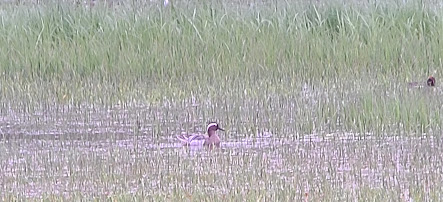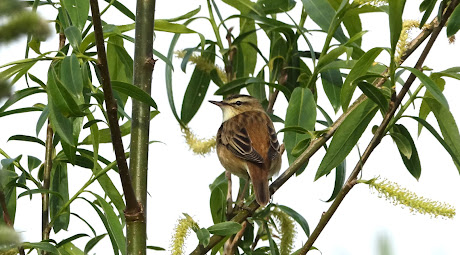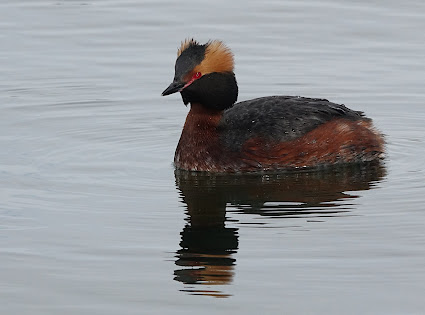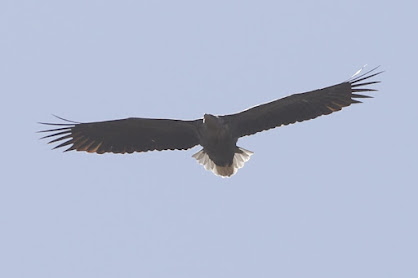Penguins are fantastic and I've been a big fan since I was a kid, when I delivered an assembly on the family to my bored-looking fellow primary school pupils. Despite the early obsession, my 40+ years of birding had delivered me only three species out of a possible 18 (Galapagos, Humboldt and African). So, the prospect of seeing at least six new species was one of the reasons I was desperate to head to the Southern Ocean and Antartica. And I wasn't to be disappointed.
Here are the penguins in the order that we saw them:
1. Magellanic Penguin
Our first encounter was from the ship as we headed east out of the Beagle Channel. These little fellas were busily feeding in the calm waters particularly in the vicinity of at least one large colony we past. Later, we saw small numbers on New Island, Falklands, where they nested in burrows in a flat grassland. Recent news that several new colonies have been discovered in Chile give optimism to offset documented declines in this species.
2. Southern Rockhopper Penguin
A dream bird to see, Rockhoppers were every bit as charismatic as I'd hoped, bouncing up and down the rocky cliffs of New Island to feed fuzz-ball chicks waiting patiently at the top. The Rockhoppers nested amid giant Black-browed Albatrosses and Falklands Shags and they all seemed to be good neighbours.
3. Gentoo Penguin
Often overlooked amid the more charismatic cousins, Gentoos are lovely birds, with gentle expressions, nesting in large open colonies on grassy plateaus. We saw a number of colonies on New Island, with other birds on South Georgia in among King and Chinstraps. Watching them literally fly out of the surf on to a white sand beach was fantastic.
4. King Penguin
One of the best wildlife experiences of my life was standing amid 100,000 pairs of King Penguins at St Andrew's Bay, South Georgia. They are the most gorgeous of birds: inquisitive, charismatic and noisy, yet at times wistful and mystical.
5. Macaroni Penguin
We saw one lonely Mac among the Southern Rockhopper colony at New Island, but our best encounter was with colonies at South Georgia, including Hercules Bay and Gold Harbour. Macs havbe heavier, redder bills than the similar Rockhoppers, and finer, deeper-yellow crests.
6. Chinstrap Penguin
I hadn't realised I'd see Chinnies on South Georgia, so this was a real bonus. Absolutely cracking penguins, and with a real affinity to ice! Our best encounters were at Gold Harbour, SG, and then on Penguin Island, South Shetlands. They feed their chicks on balls of krill, much of which ends up down their fronts or in a growing pink puddle on the colony floor! It is amazing how pristine they look on the way back to the colony and then how filthy they look as they head back to the ocean.
7. Adelie Penguin
And if six species wasn't enough, we were then treated to the two Antarctic specialities. I hoped Adelie would be a possibility around the peninsula, but by no means guaranteed. However, good fortune - or perhaps a fantastic expedition leader - was on our side and we headed down the east side into the Weddell Sea, where Adelie Penguins were abundant. And I mean abundant! Tens of thousands fed on krill in vast rafts, with others peppering every decent sized iceflow. This didn't really prepare us for the collossal colony of 250,000 pairs at the finale of our trip on an island in the northern Weddell Sea. Absolutely incredible.
8. Emperor Penguin
We always knew that if we got into the Weddell Sea there was a remote, but real chance of finding a wandering Emperor Penguin. From dawn at just before 4am, we were out on deck in subzero temperatures, checking every iceberg and iceflow we could see for large penguins. It took a while but late morning, Philip ran over to my side of the deck and asked me to check a large penguin which he was sure was an Emperor, but after hours of searching he wanted to be sure. And it was! A fantastic immature Emperor, standing forlornly on a large ice flow. The nearest colony is to the south on Snow Island (original name!) and most adults stay in the vicinity, but non-breeding youngsters wander about in the Weddell. The ship looped round and pulled up so our fellow passengers could put down their lattes and come out for a quick selfie with the world's largest penguin. This was amazing, a species I had never thought I'd ever see. To top it off, Becca then found another doing its best to hide among a gang of Adelies. Two Emperors! Unbelievable!


Top Emperor 1, bottom Emperor 2 with his cute Adelie friends
We were somewhat happy to see the Emperors!
...
So our hoped-for six species became eight and my life list of penguins rose to 13. Only five more to go...









































































